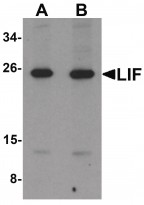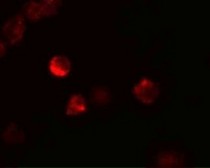ARG54923
anti-LIF antibody
anti-LIF antibody for ELISA,ICC/IF,Western blot and Human,Mouse,Rat
Cancer antibody; Cell Biology and Cellular Response antibody; Gene Regulation antibody; Immune System antibody; Neuroscience antibody
Overview
| Product Description | Rabbit Polyclonal antibody recognizes LIF |
|---|---|
| Tested Reactivity | Hu, Ms, Rat |
| Tested Application | ELISA, ICC/IF, WB |
| Specificity | At least two isoforms of LIF are known to exist. |
| Host | Rabbit |
| Clonality | Polyclonal |
| Isotype | IgG |
| Target Name | LIF |
| Antigen Species | Human |
| Immunogen | Synthetic peptide (16 aa) within aa. 50-100 of Human LIF. |
| Conjugation | Un-conjugated |
| Alternate Names | LIF; Leukemia inhibitory factor; Emfilermin; CDF; DIA; Differentiation-stimulating factor; MLPLI; HILDA; Melanoma-derived LPL inhibitor; D factor |
Application Instructions
| Application Suggestion |
|
||||||||
|---|---|---|---|---|---|---|---|---|---|
| Application Note | * The dilutions indicate recommended starting dilutions and the optimal dilutions or concentrations should be determined by the scientist. | ||||||||
| Positive Control | EL4 Cell Lysate |
Properties
| Form | Liquid |
|---|---|
| Purification | Affinity purification with immunogen. |
| Buffer | PBS and 0.02% Sodium azide |
| Preservative | 0.02% Sodium azide |
| Concentration | 1 mg/ml |
| Storage Instruction | For continuous use, store undiluted antibody at 2-8°C for up to a week. For long-term storage, aliquot and store at -20°C or below. Storage in frost free freezers is not recommended. Avoid repeated freeze/thaw cycles. Suggest spin the vial prior to opening. The antibody solution should be gently mixed before use. |
| Note | For laboratory research only, not for drug, diagnostic or other use. |
Bioinformation
| Database Links | |
|---|---|
| Gene Symbol | LIF |
| Gene Full Name | leukemia inhibitory factor |
| Background | LIF Antibody: LIF is a pleiotropic cytokine with roles in several different systems. It is involved in the induction of hematopoietic differentiation in normal and myeloid leukemia cells, induction of neuronal cell differentiation, regulator of mesenchymal to epithelial conversion during kidney development, and may also have a role in immune tolerance at the maternal-fetal interface. LIF was initially recognized by its ability to induce terminal differentiation of myeloid leukemic cells. It is a member of the IL-6 cytokine superfamily and can be highly glycosylated. LIF signaling is transduced through the LIF-R/gp130 receptor complex, leading to the phosphorylation and activation of the JAK/STAT pathway. Recent evidence shows that LIF inhibits cardiomyogenesis in embryonic stem cells via STAT3 activation. |
| Function | LIF has the capacity to induce terminal differentiation in leukemic cells. Its activities include the induction of hematopoietic differentiation in normal and myeloid leukemia cells, the induction of neuronal cell differentiation, and the stimulation of acute-phase protein synthesis in hepatocytes. [UniProt] |
| Research Area | Cancer antibody; Cell Biology and Cellular Response antibody; Gene Regulation antibody; Immune System antibody; Neuroscience antibody |
| Calculated MW | 22 kDa |
Images (2) Click the Picture to Zoom In







